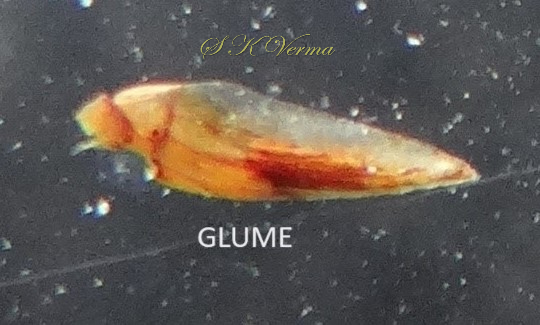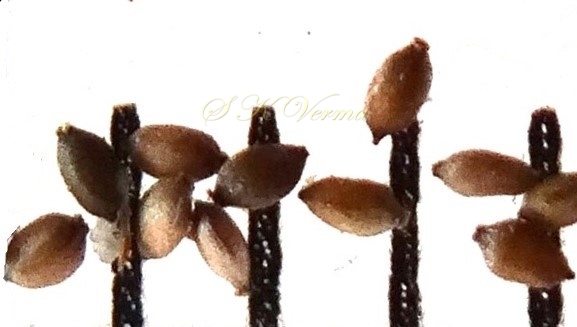CYPERUS
Cyperus
L., Sp. Pl. 1: 44. 1753; Gen. Pl., ed. 5: 26. 1754; Boiss., Fl. Or. 5: 363; 1882; Clarke in Hook. f., Fl. Brit. India 6: 597. 1894; Collett, Fl. Siml. ed. 2: 553. 1921 (Reprint 1983); Dai et al., Fl. China @ eFloras.org 23: 219; Tucker et al., Fl. North Amer. @ eFloras.org vol. 23: 141; Fl. Pak. @ eFloras.org Pakistan V. 206, p. 89.
Perennials or sometimes annuals. Rhizomes often sturdy and long creeping producing stolons, sometimes tuberous. Culms caespitose or solitary, erect, stout or slender, trigonous, terete or subterete, glabrous or scabridulous, leafy at base. Leaves crowded near the base of stem, 3- ranked, shorter or much longer than stem; leaf sheaths tubular, not split on one side; leaf blade narrow, pointed, sharp edged, usually glabrous, apex and margin barbed, blade rarely reduced; ligules absent. Involucral bracts usually 2-10 or more, spirally arranged at apex of culm at base of inflorescence, spreading to erect, leaf-like. Inflorescence variable, from a few spikes to a compact head-like structure or compound anthelodium (umbel-like). Spikes in ultimate distal partial inflorescences (cluster of spikes), spicately or digitately arranged, supported by glume- like bracts and with binerved glume-like, often spongy prophylls; compound anthelodia, with few to many rays (primary rays) and usually with raylets (secondary rays), rays and raylets unequal or equal in length. Spikelets few to many in spikes, digitate clusters or a capitulum at apex of rays, rarely single, linear, more or less flattened; rachilla persistent, usually with narrow wings. Glumes 8 to 50+, usually distichous, imbricate, basal and/ or apical, 1 to 3 glumes empty or containing male flowers, remaining glumes with a bisexual flower. Perianth bristles or scales absent. Stamens usually 1-3, free; filaments thread-like; anthers linear, bithecous, basifixed. Ovary flattened, unilocular with one basal ovule; style base not swollen, (2 or) 3-branched; stigmas (2 or) 3, deciduous at maturity. Achenes biconvex, flattened or trigonous.
951 species
Cyperus alternifolius
Cyperus alternifolius
L., Mant. Pl. 1: 28. 1767; Syst. Nat., ed. 12: 82. 1767; Chen et. al., The umbrella Sedge in Taiwan, Taiwania 53 (3): 311-315. 2008; Fl. China @ eFloras.org 23: 224; Fl. Pak. @ eFloras.org Pakistan V. 206, p. 130.
Perennial, tufted, 50-100 cm long. Rhizome short, thick; roots thick, fibrous. Stems (culms) 4-7 mm diameter, slightly stout, obtusely trigonous to subterete, smooth, glabrous, base with leaf sheath. Leaf blades reduced, leaf sheath up to 20 cm long, coriaceous, yellowish or grey, mouth margin oblique, apically scabrid; ligule absent; leaf blade absent. Inflorescence a compound anthelodium (umbel-like), 3-13 cm across; involucral bracts 11-24, up to 24 cm long and 0.5-14 mm broad, unequal margin scaberulous, foliose but few top linear, flat, margins narrowly recurved and scaberulous, teeth inconspicuous; inflorescence with 8-18 rays (primary branches), spreading, 3-10 cm long, smooth or slightly scabrous, almost terete, with basal 2-nerved tubular prophyll, basal part spongy; raylets (or secondary branches) 1-4 per ray, 1-2 cm long, with ca. 5 mm long involucral bracts; tertiary branches occasional. Each raylet at its apex with a +/- globose cluster of 5-22 spikelets arranged spirally. Spikelets linear to narrowly linear-ovoid, 4-10 mm x ca. 2 mm, with 7-40 closely imbricating glumes; each spikelet subtended by glume-like ca. 1.2 mm long, scarious bract and binerved glume-like prophyll, ca. 1.2 mm long. Rachilla 4-angled, wingless. Glumes ca. 1.5 mm long, cymbiform (boat-shaped), densely imbricate, lanceolate to elliptic, 3-nerved, mid nerve pronounced, barely reaching apex, margins scarious, colourless or pale brown. Each glume encloses a bisexual flower. Perianth absent. Stamens 3; anthers linear, ca. 1 mm long, apex setose. Style 1 mm; stigmas 3, ca. 1 mm. Nutlets brown at maturity, ellipsoid to ovoid, 0.8-0.9 mm x 0.5 mm, 3-gonous, dark brown, apex apiculate.
Common Names: Umbrella Palm, Umbrella Sedge, Umbrella papyrus
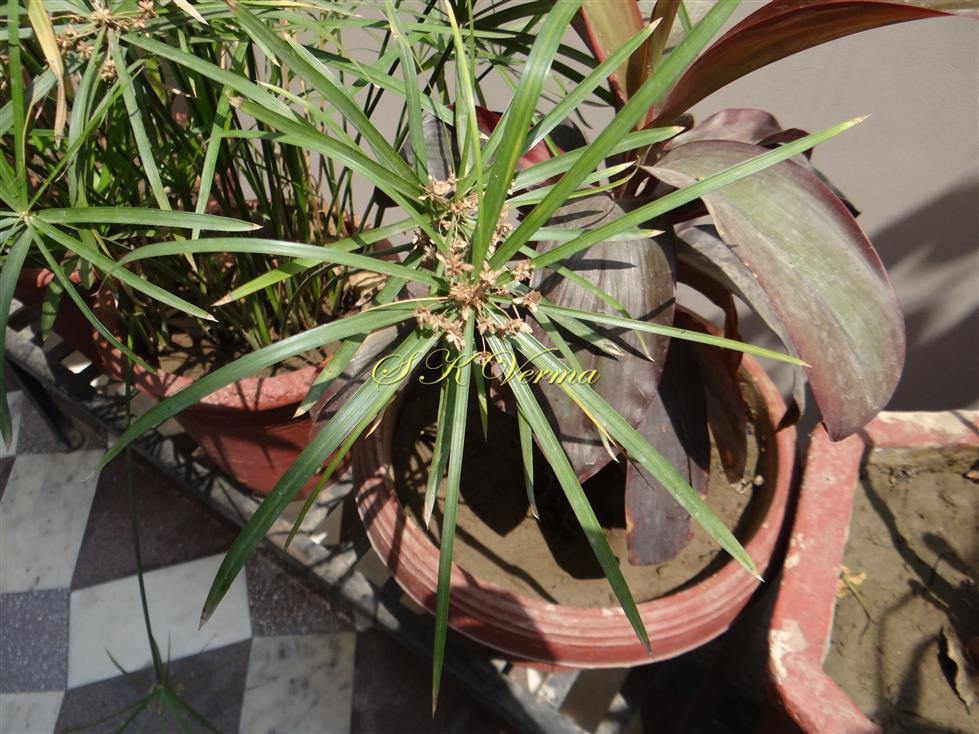
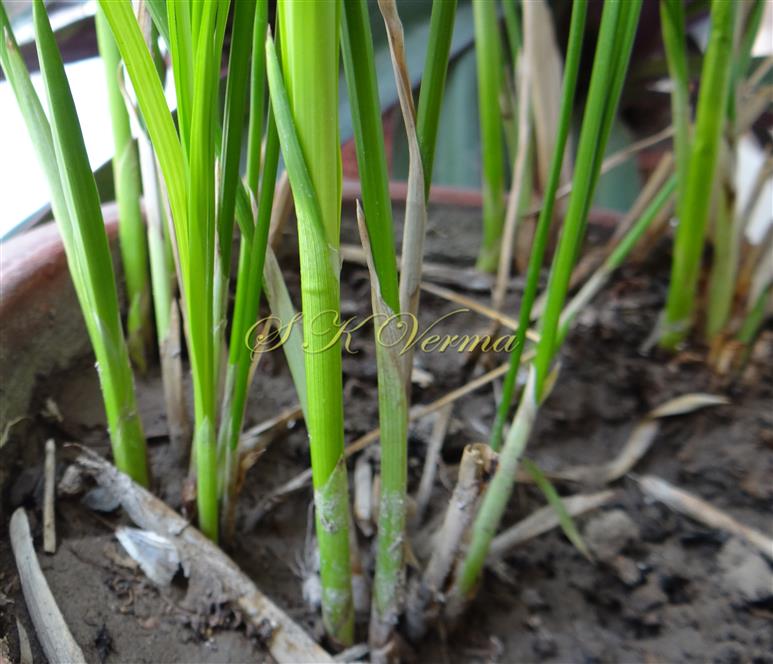


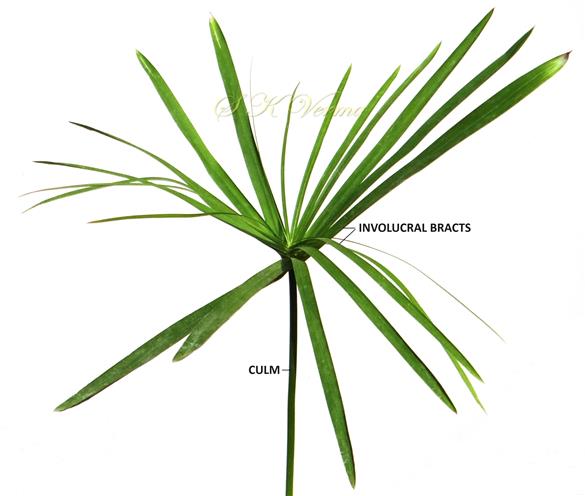
-DSC07512.jpg)
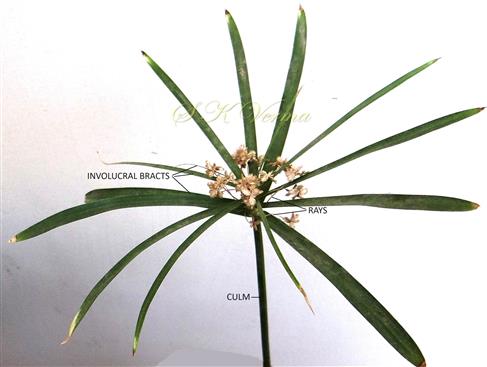
 with 4 raylets (Sec. Branches) and prophyll at base-DSC0752.jpg)
 with 4 raylets (Sec. Br.) and prophyll at base-DSC07520.jpg)
-DSC07523.jpg)
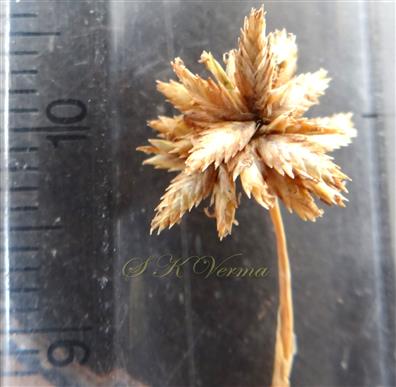
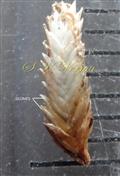

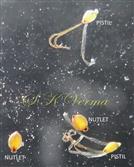







-DSC07512.jpg)

 with 4 raylets (Sec. Branches) and prophyll at base-DSC0752.jpg)
 with 4 raylets (Sec. Br.) and prophyll at base-DSC07520.jpg)
-DSC07523.jpg)


